Date palms are erect palm trees in the Arecaceae family that grow for their edible date fruit. Dates are usually found in desert environments. There are almost 220 varieties of dates, about which 20 are commercially worthwhile. Among few crops, it grows well in the desert. Usually, the height of a date palm tree is 21 to 23 meters, and it can live for up to 150 years.
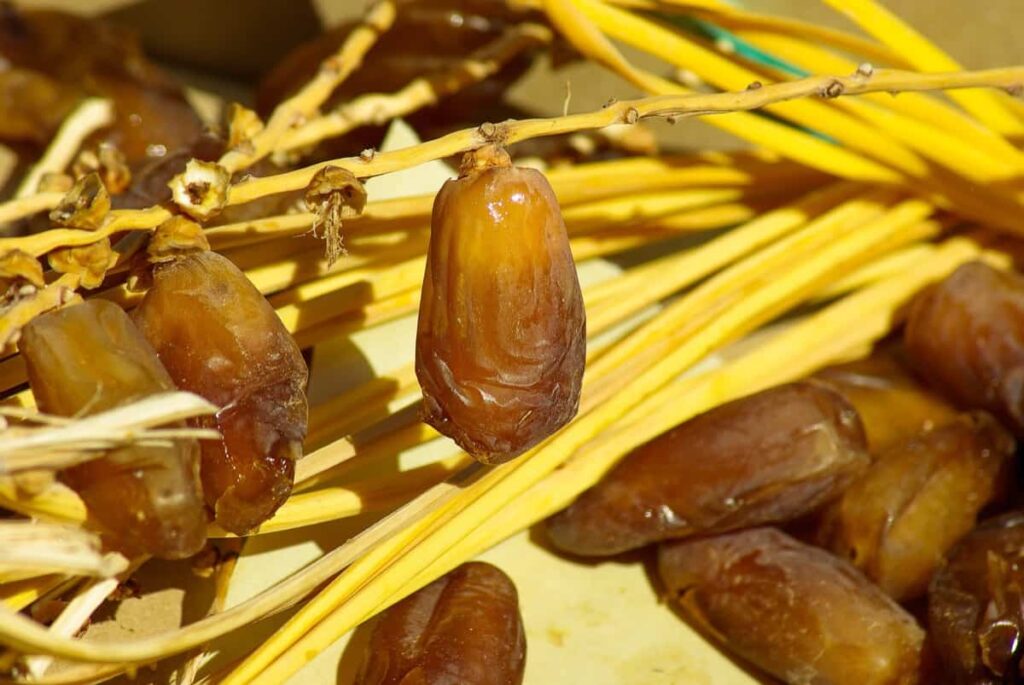
The tree grows single or forms a clump with several stems. The leaves have a length of 4 to 6 meters and have spines on the petiole. The size of the leaflets is 30 cm and 2 cm in width. The leaves are feather-like with spiny petioles and thick midrib. The leaf blades are pinnately divided and are blue-green.
The uppermost leaves of the crown stand more erect while the lower ones droop and recurve toward the trunk. The tree produces small, fragrant cream-white flowers, and the inflorescence may possess as many as 10,000 flowers. Below are the commonly occurring pests and diseases in dates crop. Keep aware of these pests and disease control methods to prevent yield losses and crop quality.
How to control pests and diseases in date plam
Major insect pests of date palm
Lesser date moth
Lesser date moth is an important insect pest of date palm infesting fruits. If not properly managed, this pest can cause more than 50% crop loss in date palms. The adult moths have a wing span of 10 to 14 mm. The front wings are lanceolate with brownish scales. The hind wings are narrow, light grey, and long-fringed. The eggs are small, pale yellow, laid singly on the flowers and immature fruits. The larvae, when fully grown, are about 10 to 12 mm long. The head and the prothorax are light browns, while the rest of the body is translucent white.
Damage symptoms
- It attacks the date fruits and causes heavy losses. There are three generations of this insect per year. It appears in April, while the fruits are in the unripe stage, and remains till September.
- The first stage of this pest is the larva, which attacks the fruits by developing an entry hole and feeding on their internal pulp, causing their shell color to change into red, a clear symptom of infestation.
- The fruits remain attached to the racemes by silken threads woven by the insect or drop off on the ground around the base of the palm. In many cases, the infested green fruits had dropped before the larva fed on their entire interior pulp.
- Usually, the infected fruits drop off due to mechanical factors such as the winds shaking the racemes or any other such aspect. When the internal tissues of the infested fruits had been examined, the presence of larva was often revealed
Biological control
- Use biological, low-toxicity pesticides, which have zero impact on the environment.
- It also includes using and preserving natural enemies such as Bracon brevicornis Phanerotoma ocularis.
Chemical control
- Chemical control is not effective unless insecticide is applied early in the season at the time of pollination, preferably using a pyrethroid to dust the fruit fronds. A spray may be needed 2–3 weeks following pollination.
- Alternatively, A formulation based on a mixture of equal parts of wheat flour and pollen grains containing chlorpyrifos, fenitrothion, or pirimiphos-methyl (all at 5 mg kg−l) was dusted onto female clusters of dates at the time of pollination.
- Results showed that, by this technique, all three insecticides effectively controlled the pest but that fenitrothion and chlorpyrifos were better than pirimiphos-methyl.
In case you missed it: Top 16 Steps to Boost Oil Palm Yield: How to Increase Production, Size, And Quality
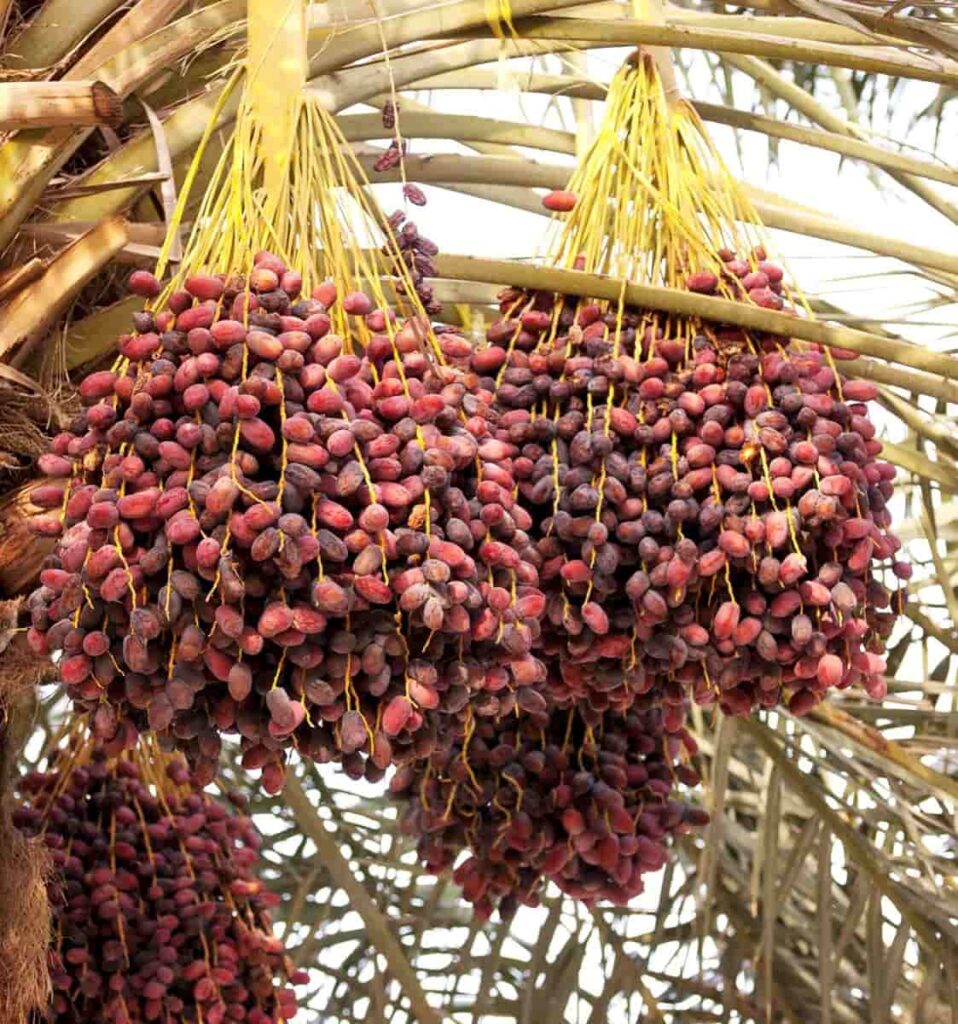
White scale
In most countries, it is a significant issue in date palm farming. Several insect pests, such as red palm weevil, lesser date moth, termites, date scales, and mealy bugs, are the major pests in date palms. Among these, the white date palm scale Parlatoria blanchardii is one of the most destructive pests. The Female lays its eggs under the shield. Adults and nymphs of this insect feed on leaves sap. A high level of infestation causes significant damage, resulting in the early dropping of leaves and yield reduction.
Symptoms of white scale
- White scales cause severe damage to young palms between two to eight years of age.
- They are sucking in nature. Nymphs and adults suck the cell sap (food) from the underside of the leaf, midribs, and dates.
- Under high infestation, leaflets become yellowish in appearance and cause the premature death of the branches.
- Due to its attack, respiration and photosynthesis are highly affected, causing early death of the infested leaf.
- It also causes less production and attacks fruit that is not marketable.
Biological control
- Horticultural oil sprays are the safest and most effective way to control scale. Oil is present in these insecticides and can mix with water. The oil coats the scale insects and clogs their breathing holes when sprayed onto infested trees.
- Beneficial insects available commercially, such as ladybugs, lacewing, soldier beetles, and parasitic wasps, are natural enemies of the early larval or crawler stage.
Chemical control
- The chemicals significantly reduced the scale infestation (at 0.05 % level), but carbosulfan 25 EC showed maximum reduction in both application methods, i.e., direct spray and basin application. However, the direct spray method was more efficient than the basin application.
Red scale
The red date scale is native to North Africa and the Middle East but has been found almost everywhere. Adult females are small, spherical-shaped insects with a body length of approximately 1 to 1.5 mm and reduced or absent legs. Adult females are red to reddish-brown and may be found embedded in a mass of white cottony wax on plant tissue. Wax forms around the body and often covers it as curly, shining white strands. Eggs are smooth, oval, and pinkish.
Damaging symptoms
- Due to its attack, date palm leaves become tiny, and minute and greyish scales appear with darker midpoints. This darker spot is oval.
- Under its severe attack, complete coverage of the leaf surfaces is seen by scales, which ultimately causes intrusion into the plant’s metabolic functions (especially photosynthesis).
- Attacked leaves and tissues may be damaged to a few millimeters. This scale initiates on roots underground. Detection the red scale is not as easy as other scales as it has a natural tendency to hide.
- This pest can attack all the exposed portions of the date palm.
Biological control
- Several species of parasitoid wasps and ladybirds can be used as biological control agents. A problem, however, is that the red scale is often guarded by ants, which obtain honeydew from them.
- A brisk wash spray of water can also help remove scales and reduce populations. Exposure of host roots to moist heat and hot water has been reported as a possible treatment
Chemical control
- The widespread use of chemicals to control red scales has led to many cases of resistance against pesticides such as chlorpyrifos and methidathion.
- As a result, many growers now use insect growth regulators such as buprofezin and Pyriproxyfen. However, these can lead to secondary pest infestations.
Disease in date farming
Bayoud disease
A fungus called Fusarium oxysporum f sp albedinis transmits the bayoud, causing rapid dieback and drying. Zagora-Morocco was the first place to report this disease in 1870. However, there had already been a significant impact on several date plantations by 1940. Later, this disease affected all Moroccan palm groves and those of the western and central Algerian Sahara. If Bayou disease is present in large urban centers, the disease can sometimes cause spectacular damage.
In case you missed it: Top 17 Steps to Boost Date Palm Yield: How to Increase Production, Quality, and Size
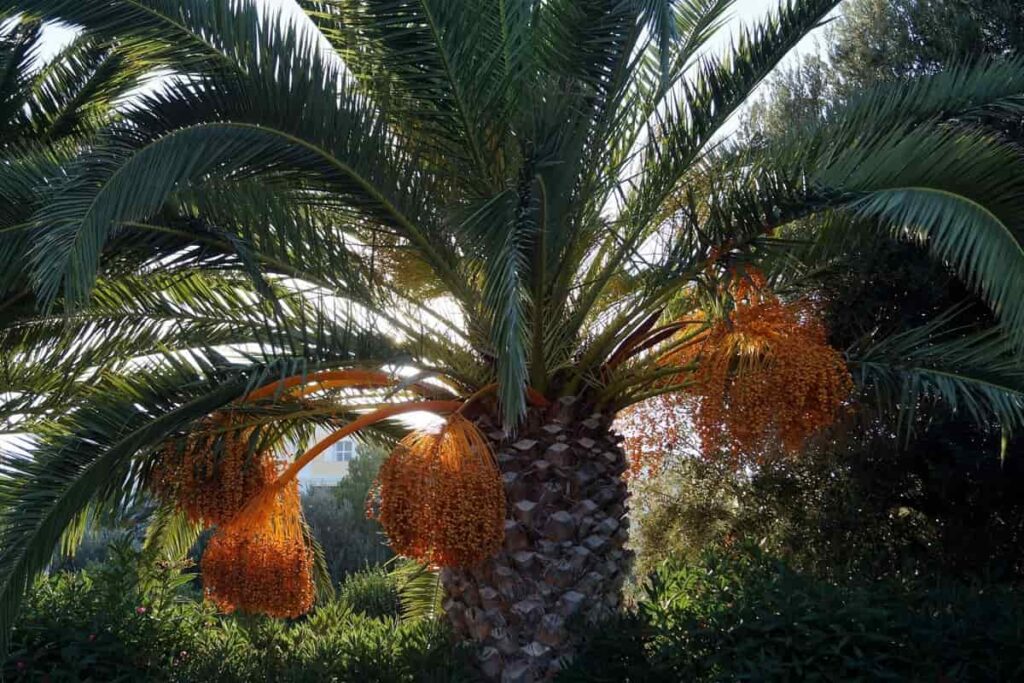
Disease symptoms
- It attacks mature and young palms and their offshoots at their bases. A palm leaf of the middle crown shows the first signs of the disease.
- In a particular way, this leaf takes on a leaden hue (ash gray) before changing to white: some pinnae or spines on one side wither progressively from the base to the apex.
- After one side is affected, the whitening begins on the other side, progressing in the opposite direction from the top
- From the base to the tip of the frond, a brown stain appears lengthwise on the rachis dorsal side.
- Following this, the frond exhibits a characteristic arch resembling a wet feather and hangs down along the trunk. It may take a few days to several weeks for the pinnae to be whitened and dyed.
Chemical control and management
It is a priori impossible to treat these types of diseases with soil treatment, so they should be avoided. However, if a healthy area is discovered to have primary sources of infection, chemical control can be effective. In this case, an eradication technique should be used: palms should be uprooted and burned immediately. Then the soil should be treated with methyl bromide or chloropicrin, and replanting is prohibited until further notice.
Black scorch disease
Also known as Medjnoon or Fool’s disease, black scorch is caused by Ceratocystis paradoxa (Hohn), the perfect form of Thielaviopsis paradoxa. Date palms have been observed with black scorch worldwide in all date-growing areas.
Symptoms
- There are usually four distinct symptoms: black scorch on the leaves, inflorescence blight, heart rot, and bud rot on palms of all ages.
- All infections result in partial or complete necrosis of tissues. The typical lesions are dark brown to black, hard, and carbonaceous, and they look like scorched charcoal on petioles, fruit strands, and fruit stalks.
- The most severe form of decay occurs when it attacks the terminal bud and heart, ultimately resulting in the palm’s death. However, in some cases, palms recover by developing lateral buds from uninjured meristematic tissue.
- There is a characteristic bend in the region of infection on these palms. The name Medjnoon derives from this fact. As a result, average growth is set back several years.
Chemical control and management
- Controlling black scorch begins with good sanitation.
- Pruning, collecting and burning the affected fronds, leaf bases, and inflorescences should be performed immediately.
- Prune cuts and surrounding tissues should be protected with Bordeaux mixtures, lime-sulfur solutions, copper sulfate lime mixtures, dichlone, thiram, or any new copper-based fungicides.
- It is recommended to burn palms affected by a severe attack.
In case you missed it: Earning 7 Lakh Per Year from Date Palms: A Date Palm Farmer Success Story
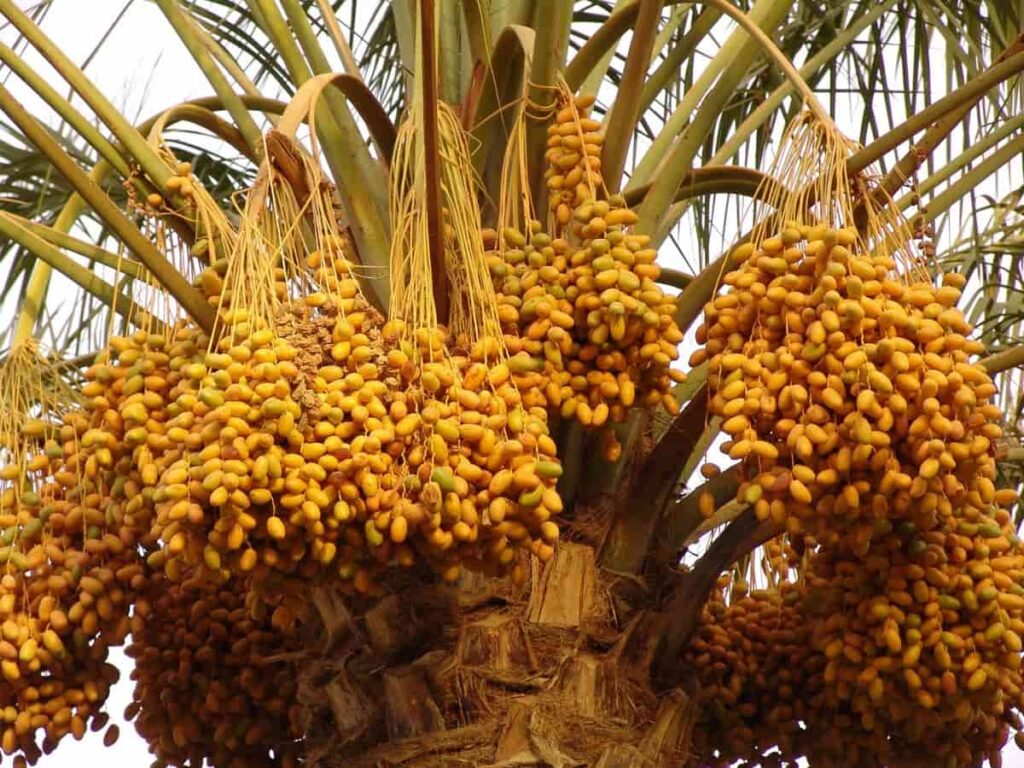
Diplodia disease
The Diplodia disease, caused by Diplodia phoenicum (Sacc), has been reported on 20 date varieties worldwide, although it seems prevalent in the Deglet Nour variety. The disease is caused by Diplodia pinea infecting susceptible plants. Saphaeropsis sapinea is another name for this fungus. Date palms 25 years or older are more susceptible to the disease. It is because younger trees are more resistant to the disease. However, if younger trees grow on poor sites or are located close to affected trees, they may become infected.
Symptoms
- Symptoms on offshoots result in death either while attached to the mother palm or once detached and planted.
- The fungus may kill younger leaves and the terminal bud, or the central cluster will be infected and die before the older leaves. Leaf bases are covered with yellowish-brown streaks.
- In older palms, the ventral mid-portion of the leaves is commonly affected, with yellowish-brown streaks extending along the leaf base and rachis. However, the upper part of the leaves may still appear green and unaffected.
Chemical control and management
The fungus usually enters the palm through the wounds made during pruning or cutting when removing the offshoots. Therefore, one precaution is to disinfect all cutting surfaces and tools. It has been found effective to dip or spray the offshoots with chemicals such as benomyl, Bordeaux mixture, methylthiophanate, thiram, and other copper-based fungicides.
Graphiola leaf spot
Graphiola leaf spot, also called “false smut” is a foliar pathogen of certain palm species. This disease is occurred due to the fungal pathogen Graphiola phoenicis. It is a unique fungus, both in appearance and life cycle, but it is widely distributed throughout the date palm-growing world. While numerous palm species have been identified as hosts of this fungus, the disease is most prevalent in Florida on date palm species, such as the Canary Islands date palm and date palm. It is rarely observed on wild date palms.
In case you missed it: Best Fertilizer for Date Palms: Organic, Compost, NPK, When and How to Apply
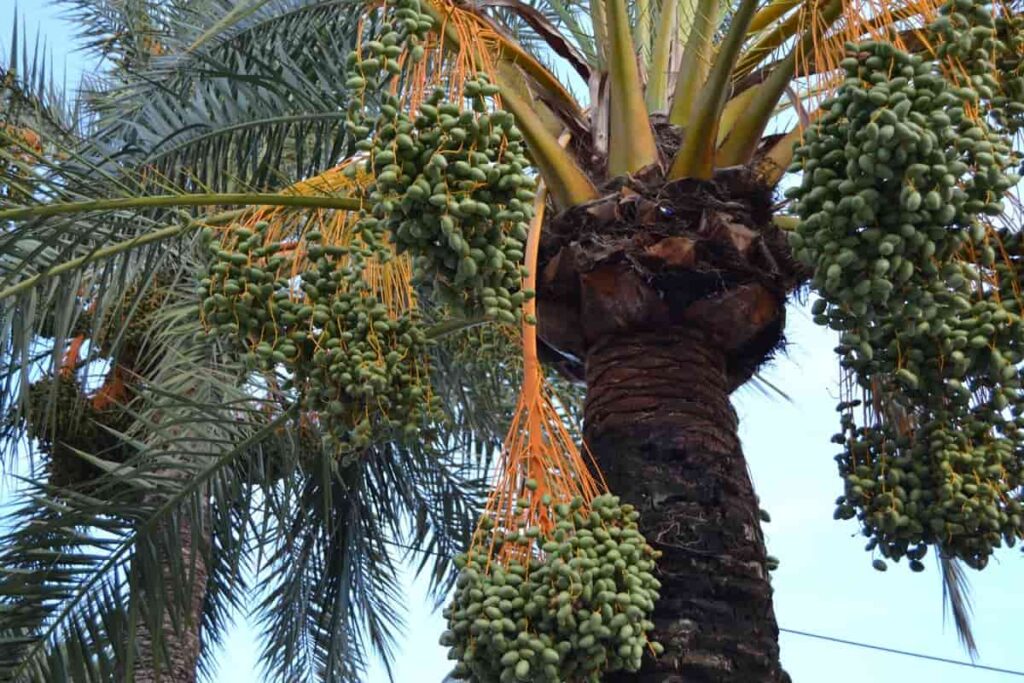
Symptoms
- The initial symptoms of the disease are very tiny (1/32 inch or less) yellow, brown, or black spots on both sides of the leaf blade. Therefore, they are easily missed without close observation.
- Date palm fronds have a typical lifespan of 6-8 years, but the Graphiola disease reduces that lifespan to 3 years and heavily infected leaves die prematurely, decreasing the palm’s yield.
- The fungus will emerge from these spots, rupturing the leaf surface. The resulting fungal reproductive structures are most commonly observed and obscure true symptoms.
Chemical control and management
- Control measures include leaf pruning and treatment with Bordeaux mixture or any large spectrum fungicide mancozeb, cupric hydroxide + maneb, and cupric hydroxide.
- Alternatively, copper oxychloride + maneb + zineb; 3 to 4 applications on a 15-day schedule after sporulation have been recommended.
Khamedj disease
Khamedj is a serious disease affecting most date-growing areas of the old world. Mauginiella scattae Cav., which causes the disease, is always found in a pure state in affected tissues. It causes damage to inflorescences in neglected palm groves in hot and humid regions or areas with prolonged periods of heavy rain 2 to 3 months before the emergence of spathes. There is an estimated loss of 30 – 40 kg of fruits per year if the disease recurs on the same palm with the same intensity each year.
Symptoms
- Brownish or rusty-colored patches appear on the external surface of unopened spathes as the first visible symptom of the disease. However, the fungus is most evident on the internal face of the spathe, where it has already begun to infect it.
- When they split, there is a partial or complete destruction of flowers and strands of the infected spathes.
- Severely damaged spathes can remain closed, and their internal contents may be completely contaminated.
- During the dry season, the inflorescences become covered with powdery fructifications of the fungus.
In case you missed it: Date Palm Cultivation In Rajasthan, Planting
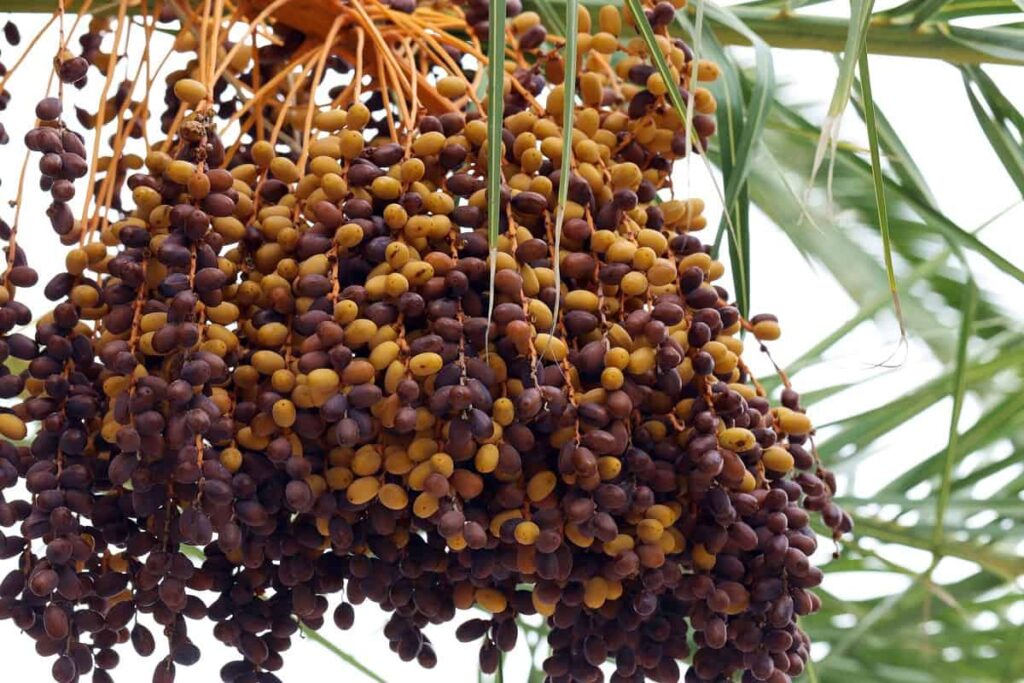
Chemical control and management
- Khamedj disease frequently appears in neglected date plantations, indicating that good sanitation and efficient maintenance are essential for controlling it.
- Once all inflorescences and spathes have been collected and burned, the diseased palms should be treated with the following fungicides after harvest and one month before spathe emergence:
- Bordeaux mixture or a copper (1/3)
- Sulfate-lime (2/3) mixture
- 3 % Dichlon spray
- 4 % thiram spray at the rate of 8 liters per palm
- with benomyl and Tuzet at the rate of 125 g/ha.
Conclusion
These pests and diseases significantly affect the yield and yield quality. However, proper management and control methods discussed above can control and prevent pests and diseases and reduce the negative effect on yields.
- Types of Pesticides Used in Agriculture: A Beginner’s Guide
- Economical Aquaculture: A Guide to Low-Budget Fish Farming
- 15 Common Planting Errors That Can Doom Your Fruit Trees
- How to Make Houseplants Bushy: Effective Tips and Ideas
- Innovative Strategies for Boosting Coconut Pollination and Yield
- Pollination Strategies for Maximum Pumpkin Yield
- The Complete Guide to Chicken Fattening: Strategies for Maximum Growth
- Natural Solutions for Tulip Problems: 100% Effective Remedies for Leaf and Bulb-Related Issues
- Revolutionizing Citrus Preservation: Towards a Healthier, Greener Future
- Natural Solutions for Peony Leaf and Flower Problems: 100% Effective Remedies
- Maximizing Profits with Avocado Contract Farming in India: A Comprehensive Guide
- Natural Solutions for Hydrangea Problems: 100% Effective Remedies for Leaf and Flowers
- The Ultimate Guide to Choosing the Perfect Foliage Friend: Bringing Life Indoors
- From Sunlight to Sustainability: 15 Ways to Use Solar Technology in Agriculture
- The Ultimate Guide to Dong Tao Chicken: Exploring from History to Raising
- The Eco-Friendly Makeover: How to Convert Your Unused Swimming Pool into a Fish Pond
- Mastering the Art of Delaware Chicken Farming: Essentials for Healthy Backyard Flocks
- 20 Best Homemade Fertilizers for Money Plant: DIY Recipes and Application Methods
- How to Craft a Comprehensive Free-Range Chicken Farming Business Plan
- Brighten Your Flock: Raising Easter Egger Chickens for Beauty and Bounty
- How to Optimize Your Poultry Egg Farm Business Plan with These Strategies
- Subsidy for Spirulina Cultivation: How Indian Government Schemes Encouraging Spirulina Farmers
- Ultimate Guide to Raising Dominique Chickens: Breeding, Feeding, Egg-Production, and Care
- Mastering the Art of Raising Jersey Giant Chickens: Care, Feeding, and More
- Ultimate Guide to Raising Legbar Chickens: Breeding, Farming Practices, Diet, Egg-Production
- How to Raise Welsummer Chickens: A Comprehensive Guide for Beginners
- How to Protect Indoor Plants in Winter: A Comprehensive Guide
- Ultimate Guide to Grow Bag Gardening: Tips, Tricks, and Planting Ideas for Urban Gardeners
- Guide to Lotus Cultivation: How to Propagate, Plant, Grow, Care, Cost, and Profit
- Agriculture Drone Subsidy Scheme: Government Kisan Subsidy, License, and How to Apply Online
- Ultimate Guide to Raising Araucana Chickens: Breed Profile, Farming Economics, Diet, and Care
- Bringing Hydroponics to Classroom: Importance, Benefits of Learning for School Students
- Ultimate Guide to Raising Polish Chickens: Breed Profile, Farming Economics, Diet, and Care
- Ultimate Guide to Raising Australorp Chickens: Profile, Farming Economics, Egg Production, Diet, and Care
- Silkie Chicken Farming: Raising Practices, Varieties, Egg Production, Diet, and Care
- Sussex Chicken Farming: Raising Practices, Varieties, Egg Production, Diet and Care